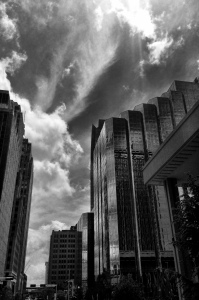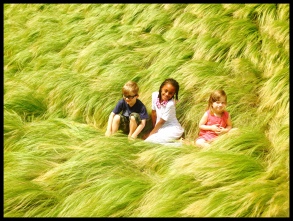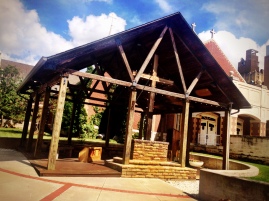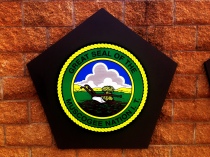We are a flexible travel family. We go and we find and we do. If we learn about something we need to experience, we head out and experience it.
Today we started with a plan… and our plan changed.
We woke up in Amarillo, about five minutes from the Cadillac Ranch art installation. Since we go and find and do, even though it was a little backtrack we went to see this Americana landmark. You can’t not, right?
It was muddy and wet from the previous night’s thunderstorm, but that only made it more appealing to these flip-flop people. They scavenged for spray paint cans and added their own elements to the work. Next time you’re there, seek out the “E,” “J,” and “C” on the westernmost Caddy.


After the Ranch we stopped in at the Cavendar’s to find Texas Boy a Texas Shirt, but we had no luck. That’s what the Internet is for, right? One of these will be waiting for Texas Boy when we get home.
Then it was time to get on the road. These western states are huge, y’all, and if we’re going to make it through #thirteenstates we have to log some miles.

Oklahoma countryside
We cruised through the Texas Panhandle and on into Oklahoma.  We had planned to head straight through to Okmulgee and Muscogee, towns that were of interest to me because of my family history, but when we checked the map and realized we’d be driving right through Oklahoma City, we added a stop.
We had planned to head straight through to Okmulgee and Muscogee, towns that were of interest to me because of my family history, but when we checked the map and realized we’d be driving right through Oklahoma City, we added a stop.
On April 19, 1995, the deadliest act of domestic terrorism was committed in downtown Oklahoma City. When a truck bomb detonated outside the Alfred P. Murrah Federal Building, 168 people were killed, 19 of whom were children under the age of six. In the place of that destruction now stands a beautiful memorial that we wanted to witness.

Oklahoma City Skyline
If we were going to go visit this place and take our three little children, we knew we had to tell them that it was a memorial and tell them how to behave there. If we told them it was a memorial and a quiet, reverent place, we were going to have to tell them what happened there. We’re kind of shelter-y parents. We talk a lot more now with Miss Pickle about world events because she hears about them at school, but we don’t bring up a lot of sad or scary events with the kids. I prefer to allow them to have a quieter, less stressful childhood, so unless I know something is going to come up at school and I think she should hear it from me first, we pretty much let her stay a kid. But taking the kids into this place, we knew we needed to prepare them.
About an hour before we arrived in OKC I turned around in the front seat to talk to my kids. I told them about the angry men who were upset with the government and decided to use violence to make a statement. I told them about the innocent people who were injured and killed there, including children. I told them how the place where it happened became a memorial, and that they needed to be respectful of the sad thing that happened there that day.
And then I told them about Survivor Tree.
Survivor Tree is a hundred-year-old American elm that stood in a parking lot across the street from the Murrah building. People would come in to work early to find a parking spot in the tree’s shade, a little bit of respite from the sun. The day of the attack, Survivor Tree was nearly destroyed. Evidence from the blast was embedded in its trunk, its limbs were blown off by the force of the explosion, and fire from the cars parked near it that day charred it so badly that people didn’t think it would live.
But, I told my kids, a year later when victims and friends and loved ones gathered for a memorial service there, they noticed blossoms forming. Survivor Tree survived, and now it stands as a symbol of the resilience of the people of Oklahoma and of the United States. It stands as a symbol to us that if our roots are deep and strong, we can survive hard things and come back even more beautiful than before.
We asked if they wanted to go see this place and if they would have appropriate behavior there, and they all said they did and they would, so we headed for downtown Oklahoma City.
A few minutes after I finished telling them the story and turned back to help our driver navigate, a voice called out from the backseat. It was my five-year-old son.
“Mommy, I like the story about Survivor Tree. I was afraid when you told us about it that the tree would die, but I’m glad it was a happy ending. I’m glad Survivor Tree is still there to make people feel better. I want to go see it.”
We had lunch at the delightful Kitchen No. 324, where we were seated outside near a small grassy area where the wiggly among us could wiggle. It was perfect since we knew we were going to let them walk around the memorial but not run and jump and somersault and cartwheel, which they really needed to do. We enjoyed the “Oklahoma fluffies” and let the wind come roaring down the plains and through our hair.



After lunch we went to the memorial.  As we approached it from the east, the kids were drawn to an outdoor chapel on the ground of First Church. That boy who was touched by the story of Survivor Tree asked if we could kneel in the sanctuary and pray. He offered the sweetest, simplest prayer for the people affected on that day and for the tree that brought hope. It was the perfect way to start our visit to the memorial — where somehow they all managed to behave.
As we approached it from the east, the kids were drawn to an outdoor chapel on the ground of First Church. That boy who was touched by the story of Survivor Tree asked if we could kneel in the sanctuary and pray. He offered the sweetest, simplest prayer for the people affected on that day and for the tree that brought hope. It was the perfect way to start our visit to the memorial — where somehow they all managed to behave.



After OKC, it was time to get on the road again.  We went to Okmulgee, Oklahoma, which is the government seat of the Muscogee (Creek) Nation, where I am a tribal member. My great-great-grandmother was named on the 1906 Dawes Indian Census, along with two sisters and a brother. Her family a few generations back had come to Oklahoma on the Trail of Tears, and her descendants remained there until as a young boy my Gramps left Oklahoma with his family during the Dust Bowl, headed for California. California was a little too far to travel, it seems. The family ended up settling in Arizona, and now here we are.
We went to Okmulgee, Oklahoma, which is the government seat of the Muscogee (Creek) Nation, where I am a tribal member. My great-great-grandmother was named on the 1906 Dawes Indian Census, along with two sisters and a brother. Her family a few generations back had come to Oklahoma on the Trail of Tears, and her descendants remained there until as a young boy my Gramps left Oklahoma with his family during the Dust Bowl, headed for California. California was a little too far to travel, it seems. The family ended up settling in Arizona, and now here we are.
 In Okmulgee we went to the Creek Council House, which was erected in 1878 shortly after their arrival in Oklahoma Territory. It was very moving to be in the place where my family had been for many years, which I had never seen. Gramps died when I was young and any memories of his life in Oklahoma are lost to me for now, but researching that part of my family history has been very meaningful to me. I feel a connection to that great-great-grandmother, and I’m so glad I got to walk in the place where she lived.
In Okmulgee we went to the Creek Council House, which was erected in 1878 shortly after their arrival in Oklahoma Territory. It was very moving to be in the place where my family had been for many years, which I had never seen. Gramps died when I was young and any memories of his life in Oklahoma are lost to me for now, but researching that part of my family history has been very meaningful to me. I feel a connection to that great-great-grandmother, and I’m so glad I got to walk in the place where she lived.
We had intended to continue on to Muscogee, Oklahoma, where the Five Civilized Tribes Museum honors those who were relocated to Indian Territory during the Trail of Tears — the Cherokee, Creek, Choctaw, Chickasaw, and Seminole. Our stops in OKC and Muscogee put us behind schedule, though, and we would have arrived in Muscogee after the museum had closed, so we decided to turn north and head into Kansas.
 We crossed the state line into Kansas at Coffeyville, where I missed my “Welcome to Kansas” picture and made the driver turn around to give me a second try. Whew! We marveled at the W.P.Brown Mansion as we cruised through, an enormous home built in 1906 by a local natural gas magnate. Late night Kansas backroads took us up to Overland Park (“Fancy Kansas,” according to my favorite Kansan), where we rolled in well past everyone’s bedtimes and promptly got to bed.
We crossed the state line into Kansas at Coffeyville, where I missed my “Welcome to Kansas” picture and made the driver turn around to give me a second try. Whew! We marveled at the W.P.Brown Mansion as we cruised through, an enormous home built in 1906 by a local natural gas magnate. Late night Kansas backroads took us up to Overland Park (“Fancy Kansas,” according to my favorite Kansan), where we rolled in well past everyone’s bedtimes and promptly got to bed.

